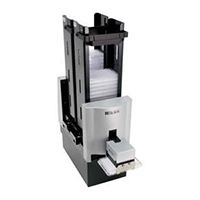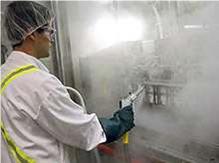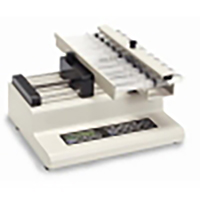Lead screws are often regarded as the less expensive alternative to ball screws – suitable only for light-duty applications with low precision requirements. While it’s true that ball screws often have the advantage over lead screws when it comes to load capacity and rigidity, lead screws’ reliance on sliding, rather than rolling, motion makes them the better choice for some applications. Below are five areas where lead screws can outperform ball screws.
Vertical Operation
Lead screws are based on sliding contact between the nut and the screw, which makes them less efficient than ball screws. But in a vertical application, this inefficiency has a benefit: it can prevent the load from backdriving when the motor is powered off. This ability to maintain a vertical load without backdriving is important in applications where the load needs to wait at the top of its stroke while other processes take place, such as tray stacking and parts sorting. In order to use a ball screw in these applications, a brake or holding device would be needed, whereas a lead screw can typically (depending on its efficiency) hold a vertical load without the use of a brake.

Cleanroom Environments
Lubrication is a liability in cleanroom environments, since oils and greases are major sources of contamination. And while a ball screw (or any metal-to-metal contact bearing) requires lubrication, a lead screw made of stainless steel with a self-lubricating polymer nut does not, making it the more cleanroom-friendly option. This is especially important in medical, laboratory, and electronics applications, where not only is it essential to maintain the integrity of the cleanroom, but where airborne lubrication particles would cause damage to delicate parts or processes.
Highly Contaminated Environments
Because their motion relies on sliding friction rather than rolling elements, lead screws are much more tolerant than ball screws of dust, chips, and debris. And despite harsh environmental conditions, lead screws don’t require seals – which add friction and can need frequent replacement – since there’s no lubrication to keep in, and keeping contamination out is not as critical as it is for ball screws. Applications such as woodworking and paper processing, which produce a considerable amount of dust and chips, can shorten ball screw life significantly, while lead screws can withstand these environments with very little effect on performance or life.
Washdown Applications
With no lubrication to be flushed out, and a wide variety of materials and coatings for both the screw and the nut, lead screws are an excellent choice for washdown environments. This is especially beneficial in food and beverage processing and packaging applications, where equipment must be regularly washed and sanitized. Some lead screws can even operate when completely submerged in water, making them suitable for water-jet applications.

Low Noise Applications
The steel-on-steel rolling elements and recirculation inherent in ball screws cause them to generate significant noise. Lead screws, on the other hand, produce relatively little noise, since they rely on sliding motion, with no rolling elements. Because of their low noise level, lead screws are often used in laboratory automation and medical imaging equipment, where the environment is inherently quiet, and users or patients could be disturbed by excessive noise. Consumer devices, such as printers, scanners, and appliances also require low-noise components, where lead screws are the preferred choice over ball screws.

Lead screws have moved beyond the realm of low-precision, basic linear motion devices, aided by anti-backlash nuts for higher precision and materials that can withstand challenging environments. With these advances, designers and OEMs are using lead screws in areas once thought to be suitable only for high-precision ball screws, proving that yes, lead screws can outperform ball screws in some applications.


Leave a Reply
You must be logged in to post a comment.